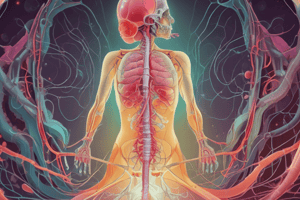Podcast
Questions and Answers
What process describes the movement of water from an area of lower concentration to an area of higher concentration?
What process describes the movement of water from an area of lower concentration to an area of higher concentration?
- Homeostasis
- Osmosis (correct)
- Filtration
- Diffusion
What is required for the active transport of electrolytes from an area of higher concentration to an area of lower concentration?
What is required for the active transport of electrolytes from an area of higher concentration to an area of lower concentration?
- Osmotic pressure
- Hydrostatic pressure (correct)
- Pulse pressure
- Blood pressure
How is the chemical activity of electrolytes expressed?
How is the chemical activity of electrolytes expressed?
- Moles
- Milligrams
- Milliequivalents (correct)
- Liters
What is the average daily fluid intake and output range for a healthy adult?
What is the average daily fluid intake and output range for a healthy adult?
Which electrolyte has the same combining power as 1 mEq of potassium?
Which electrolyte has the same combining power as 1 mEq of potassium?
What is the minimum hourly urine output required for the kidneys to effectively remove waste?
What is the minimum hourly urine output required for the kidneys to effectively remove waste?
What occurs during passive transport of oxygen into the lungs?
What occurs during passive transport of oxygen into the lungs?
What does weighing a patient under the same conditions daily help to accurately assess?
What does weighing a patient under the same conditions daily help to accurately assess?
What is the most abundant electrolyte in the body?
What is the most abundant electrolyte in the body?
After substances enter the body, which compartment must they enter to function properly?
After substances enter the body, which compartment must they enter to function properly?
What type of transport process does not require energy to move substances?
What type of transport process does not require energy to move substances?
What method involves the movement of inhaled oxygen into the blood vessels?
What method involves the movement of inhaled oxygen into the blood vessels?
Which pressure is associated with the movement of fluids in relation to the blood vessels?
Which pressure is associated with the movement of fluids in relation to the blood vessels?
What is the typical range for urinary output in a day for a healthy adult?
What is the typical range for urinary output in a day for a healthy adult?
Which of the following is necessary for the kidneys to function effectively in waste removal?
Which of the following is necessary for the kidneys to function effectively in waste removal?
What occurs within the extracellular compartment after substances are ingested?
What occurs within the extracellular compartment after substances are ingested?
What is the expected calcium level that indicates hypercalcemia?
What is the expected calcium level that indicates hypercalcemia?
What is the correct carbonic acid to bicarbonate ratio for homeostasis?
What is the correct carbonic acid to bicarbonate ratio for homeostasis?
If a patient has a blood pH of 7.10 and normal oxygen readings, what condition might they be experiencing?
If a patient has a blood pH of 7.10 and normal oxygen readings, what condition might they be experiencing?
Which symptom is associated with respiratory alkalosis?
Which symptom is associated with respiratory alkalosis?
What might happen to a patient who is immobilized regarding calcium levels?
What might happen to a patient who is immobilized regarding calcium levels?
Which of the following is a potential consequence of hypercalcemia?
Which of the following is a potential consequence of hypercalcemia?
In the context of acid-base balance, a blood pH below 7.35 is indicative of which type of acidosis?
In the context of acid-base balance, a blood pH below 7.35 is indicative of which type of acidosis?
What physiological change is likely to occur during respiratory alkalosis?
What physiological change is likely to occur during respiratory alkalosis?
What is the correct order of effectiveness for the blood buffers, lungs, and kidneys?
What is the correct order of effectiveness for the blood buffers, lungs, and kidneys?
What condition results from hyperventilation due to extreme anxiety?
What condition results from hyperventilation due to extreme anxiety?
What is the likely consequence of prolonged vomiting?
What is the likely consequence of prolonged vomiting?
How quickly do blood buffers respond to changes in pH?
How quickly do blood buffers respond to changes in pH?
What is the primary function of the kidneys in pH regulation?
What is the primary function of the kidneys in pH regulation?
Which vital sign increase is associated with respiratory alkalosis?
Which vital sign increase is associated with respiratory alkalosis?
What nursing intervention is important for a patient with metabolic acidosis?
What nursing intervention is important for a patient with metabolic acidosis?
The lungs take how long to respond to pH changes?
The lungs take how long to respond to pH changes?
What is the result of deep-breathing exercises related to CO2 levels in the body?
What is the result of deep-breathing exercises related to CO2 levels in the body?
Which of the following food pairs is rich in potassium?
Which of the following food pairs is rich in potassium?
What are two examples of passive transport processes?
What are two examples of passive transport processes?
Which systems serve as buffer systems in the body?
Which systems serve as buffer systems in the body?
What is the minimum urine volume an adult with normal kidney function should void in 4 hours?
What is the minimum urine volume an adult with normal kidney function should void in 4 hours?
Which of these is NOT a type of passive transport?
Which of these is NOT a type of passive transport?
What effect does increasing pH have on acidity in the body?
What effect does increasing pH have on acidity in the body?
Which of the following food pairs has the lowest potassium content?
Which of the following food pairs has the lowest potassium content?
Flashcards are hidden until you start studying
Study Notes
Fluid Intake and Output
- Daily fluid intake and output is typically between 2200 to 2700 mL/day.
- Typical urine output is between 1000 to 2000 mL/day.
Kidney Efficiency
- The kidneys must produce at least 30 mL/h of urine output to eliminate waste products.
Water Balance
- Weighing a patient at the same time of day, with the same scale and clothing, is a simple and accurate way to assess water balance.
Body Compartments
- Substances entering the body first enter the extracellular compartment.
- To carry out their functions, substances must then enter the intracellular compartment.
Transport Processes
- Passive transport: The movement of substances across a membrane without energy expenditure.
- Diffusion: Movement of a substance from an area of higher concentration to an area of lower concentration.
- Osmosis: Movement of water across a semi-permeable membrane from an area of lower solute concentration to an area of higher solute concentration.
- Filtration: Movement of water and small solutes across a membrane from an area of higher pressure to an area of lower pressure.
- Active transport: The movement of substances across a membrane with energy expenditure.
- Active transport requires hydrostatic pressure.
Electrolytes
- Electrolytes are measured in milliequivalents (mEq).
- 1 mEq of any electrolyte is equal to 1 mEq of hydrogen.
- Sodium is the most abundant electrolyte in the body.
Hypercalcemia
- Hypercalcemia occurs when calcium levels exceed 5.8 mEq/L.
- Can occur when calcium stored in bone is released into circulation (e.g., immobilized patients).
- Risk factors: Renal calculi may develop due to high calcium levels.
Acid-Base Balance
- Homeostasis of hydrogen ion concentration in body fluids depends on the ratio of carbonic acid to bicarbonate in the extracellular fluid.
- Normal ratio: 1 part carbonic acid to 20 parts bicarbonate.
- Metabolic acidosis: Blood pH below 7.35, normal oxygen readings.
- Respiratory alkalosis: Hyperventilation can cause this, with symptoms including tetany, muscle weakness, tachypnea, and cardiac arrhythmias.
- Buffer systems:
- Bicarbonate/carbonic acid system
- Respiratory system
- Renal system
Nursing Interventions for Acid-Base Imbalances
- Metabolic acidosis: Deep breathing exercises can help increase pH and reduce acidity.
- Hyperventilation: Encourage slow, deep breaths to reduce CO2 loss.
Potassium-Rich Foods
- Apricots and asparagus are high in potassium.
Studying That Suits You
Use AI to generate personalized quizzes and flashcards to suit your learning preferences.




